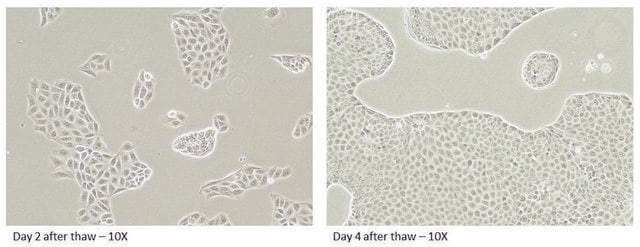MTOX1002
BCRP Knockout Caco-2 Cells
Human male colorectal tissue, adenocarcinoma
Synonym(s):
C2BBe1 Cells BCRP (-/-/-/-)
Sign Into View Organizational & Contract Pricing
All Photos(1)
About This Item
UNSPSC Code:
41106514
NACRES:
NA.81
Recommended Products
product name
BCRP Knockout Caco-2 Cells, one vial
biological source
human male colorectal tissue (Source disease: adenocarcinoma)
form
liquid
technique(s)
drug transporter assay: suitable
permeability assay: suitable
OMIM accession no.
application(s)
ADME/TOX
storage temp.
−196°C
Gene Information
human ... ABCG2(9429)
General description
The C2BBe1 cells, a subclone of Caco-2 cells, correspond to ATCC CRL-2102. The BCRP knockout C2BBe1 cells are adenocarcinoma, epithelial cells from a human caucasian male (aged 72 years) with functional knockout of the ABCG2 (BCRP) efflux transporter.
Application
The following posters and articles demonstrate how Caco-2 cells can be used for cell based assays:
Transporter Function in Caco-2 Cells with Targeted P-Glycoprotein, MRP2 and BCRP Gene Knockout Using Zinc Finger Nucleases
Comparison of Function and Relative Transporter Protein Concentrations in Caco-2 Cells with Single and Double Knockouts of the ABCB1, ABCG2, and ABCC2 Genes
Caco-2 Transporter Knockout Cell Based Assays
Transporter Function in Caco-2 Cells with Targeted P-Glycoprotein, MRP2 and BCRP Gene Knockout Using Zinc Finger Nucleases
Comparison of Function and Relative Transporter Protein Concentrations in Caco-2 Cells with Single and Double Knockouts of the ABCB1, ABCG2, and ABCC2 Genes
Caco-2 Transporter Knockout Cell Based Assays
Features and Benefits
The Caco-2 subclone C2BBe1 cells are ideal for transporter analysis as they express multiple transporters, are human derived, and grow in a homogenous monolayer that forms tight junctions necessary for efflux ratio analysis. Other benefits include:
- A functional knockout of the BCRP gene eliminates the reliance on chemical inhibitors to determine if a compound is an BCRP substrate
- The vial format enables the BCRP knockout cells to be included in standard drug transporter protocols
- Human assay with no interference from animal inhibitors
- Overcome the limitations of RNAi and knockdown cell lines that arise from remaining transporter functionality
Legal Information
Disclaimer
RESEARCH USE ONLY. This product is regulated in France when intended to be used for scientific purposes, including for import and export activities (Article L 1211-1 paragraph 2 of the Public Health Code). The purchaser (i.e. enduser) is required to obtain an import authorization from the France Ministry of Research referred in the Article L1245-5-1 II. of Public Health Code. By ordering this product, you are confirming that you have obtained the proper import authorization.
Kit Components Also Available Separately
Product No.
Description
SDS
- MTOX1002BCRP Knockout Caco-2 Cells, one vial 1 vialSDS
Storage Class Code
10 - Combustible liquids
WGK
WGK 3
Flash Point(F)
Not applicable
Flash Point(C)
Not applicable
Certificates of Analysis (COA)
Search for Certificates of Analysis (COA) by entering the products Lot/Batch Number. Lot and Batch Numbers can be found on a product’s label following the words ‘Lot’ or ‘Batch’.
Already Own This Product?
Find documentation for the products that you have recently purchased in the Document Library.
P Artursson
Journal of pharmaceutical sciences, 79(6), 476-482 (1990-06-01)
A human intestinal cell line, Caco-2, was used as a model to study the passive diffusion of drugs across intestinal epithelium. The cells formed continuous monolayers when grown on permeable filters of polycarbonate. After 10 days in culture, the monolayers
V Pade et al.
Journal of pharmaceutical sciences, 87(12), 1604-1607 (1999-04-03)
The objective of this investigation was to establish a relationship between drug permeability and solubility in vitro and the extent of drug absorption in humans. We selected drugs with varying permeabilities and solubilities with the aim of establishing a relationship
X Wu et al.
Pharmaceutical research, 17(2), 209-215 (2000-04-06)
The purpose of this study was to elucidate the mechanisms by which an HMG-CoA reductase inhibitor, atorvastatin (an organic acid with a pKa of 4.46), was transported in the secretory and absorptive directions across Caco-2 cell monolayers. Caco-2 cells were
M J Briske-Anderson et al.
Proceedings of the Society for Experimental Biology and Medicine. Society for Experimental Biology and Medicine (New York, N.Y.), 214(3), 248-257 (1997-03-01)
The Caco-2 cell line is used by many investigators as a model of the intestinal epithelium to study nutrient uptake and transport. Our goal was to create an awareness of inherent variabilities in the Caco-2 cell line which may influence
Mark I Kaldas et al.
The Journal of pharmacy and pharmacology, 55(3), 307-312 (2003-05-02)
Resveratrol is a dietary constituent suggested to have protective effects against cancer as well as cardiovascular disease. The purpose of the study was to learn whether this agent could be absorbed in man and enter the systemic circulation. This was
Our team of scientists has experience in all areas of research including Life Science, Material Science, Chemical Synthesis, Chromatography, Analytical and many others.
Contact Technical Service








